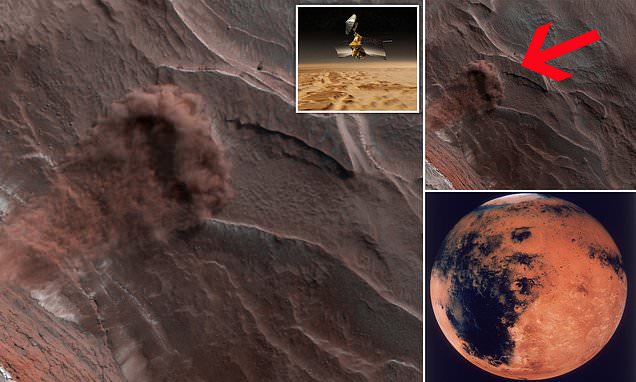NASA’s Reconnaissance Orbiter captures incredible image of a massive avalanche of ICE tumbling down a mountain side on the red planet
- Images captured by Mars Reconnaissance Orbiter show dramatic plume of dust
- The catalyst for this was increased sunlight, which effectively melted glaciers
- Rare site was made public on Tuesday by engineers at the University of Arizona
NASA has captured a stunning image of an avalanche on Mars, caused by the dawn of spring on the desolate planet.
Experts identified the remarkable event when a cloud of dust tumbled down a mountain side, which they believe was caused by falling ice at the north pole.
Spectacular images, captured by the Mars Reconnaissance Orbiter, show a plume of dust above the red planet’s surface.
The rare site was made public by engineers at the University of Arizona, who created the satellite’s High Resolution Imaging Science Experiment telescope.
Scroll down for video
Movement: The incident, captured by the Mars Reconnaissance Orbiter, shows a plume of dust above the red planet’s surface – a rare sighting for the NASA team
WHAT IS SPRINGTIME ON MARS LIKE?
There are four seasons on Mars, but each of these vary in length over the course of a 687-day year.
In the northern hemisphere, springtime typically lasts for seven months, but – unlike Earth – it isn’t accompanied by dramatically warmer weather.
In fact, the temperatures are always -20 or less, but the changes from winter are enough thaw polar caps.
The southern hemisphere is warmer in the spring and summer, often reaching 30C, because it’s closer to the sun.
The natural wonder is thought to have happened when huge ice blocks at the planet’s north pole dislodged and fell down a 1,640-foot (500-meter) cliff face in May.
The catalyst was increased sunlight, which effectively melted the glaciers.
‘Every spring the sun shines on the side of the stack of layers at the North Pole of Mars known as the north polar layered deposits,’ says Candy Hansen, from the University of Arizona.
‘The warmth destabilises the ice and blocks break loose. When they reach the bottom of the more than 500 meter tall cliff face.
‘The layers beneath are different colors and textures depending on the amount of dust mixed with ice.’
Not that this is the first time the MRO has impressed people on Earth.
On February 19, 2008, it captured a similar avalanche on Mars during the springtime. However, unlike the latest incident, experts believe this was caused by a meteorite impact – not by warmer weather.
MRO’s instruments analyse minerals, look for subsurface water, trace how dust and water are distributed in the atmosphere, and monitor daily weather in support of its science objectives.
MRO’s missions have shown that water flowed across the Martian surface, but it is still unknown whether water persisted long enough to provide a habitat for life.
It was first launched in August 2005.
Focus: Over the years, scientists have found evidence of water, chemical reactions, and expansive ice lakes beneath the surface of Mars
DO SCIENTISTS BELIEVE WE COULD EVER FIND LIFE ON MARS?
Over the years, scientists have found a number of promising signs that life may have been present on Mars, including evidence of water, chemical reactions, and expansive ice lakes beneath the surface.
Life on Mars is unlikely to have flourished on the surface, given the harsh conditions – including radiation, solar winds, and frigid temperatures.
As a result, many scientists believe organisms evolved to live beneath the surface of the Red Planet.
In November 2016, Dr Christian Schröder, an environmental science and planetary exploration lecturer at Stirling University, said: ‘For life to exist in the areas we investigated, it would need to find pockets far beneath the surface, located away from the dryness and radiation present on the ground.’
This is supported by evidence of water beneath the surface.
Researchers have identified mudstones and sedimentary bands on Mars, which only form when there is water present for thousands of years.
Vast oceans of ice have also been uncovered, lying just below the surface of the planet.
The presence of ice and water beneath the Red Planet greatly increases the chances that there was once at least microscopic life on Mars and that some form of the organism could be living there today.
‘Any place on Earth we find liquid water we find life,’ Jim Crocker, vice president of Lockheed Martin’s Space Systems said in August 2016.
‘It’s very exciting to understand the possibility that life could possibly have started on Mars before it lost its atmosphere, and perhaps even in the deeper surfaces, where water is still liquid because of the heat of the planet, perhaps there’s bacterial life.’
Having water just below the surface also means that human colonies could survive and even thrive on the planet and indicates that fuel for manned spaceflight could be manufactured there.
In 2017, Nasa’s Curiosity rover also found evidence of boron on the red planet’s surface.
This is another key ingredient for life, and scientists say the find is a huge boost in the hunt for life.
Boron was unearthed in the Gale Cater, which is 3.8 billion years old, younger than the likely formation of life on Earth.
That means the conditions from which life could have potentially grown may have existed on ancient Mars, long before organisms began to develop on Earth.
A controversial 2001 study into a 4.5 billion-year-old meteorite, dubbed ALH84001, which was found in Antarctica’s Allan Hills ice field in 1984, claimed it had definitive prove of life on Mars.
Meteorite ALH84001 was blasted off the surface of Mars by a comet or asteroid 15 million years ago, and Nasa researchers said it contains proof the Red Planet was once teeming with bugs which lived at the bottom of shallow pools and lakes.
They also suggested there would have been plants or organisms capable of photosynthesis and complex ecosystems on Mars.
However British experts said at the time that the evidence, though exciting, had to be treated with caution and could not be taken as conclusive, since many non-biological chemical processes could also explain what was found.
Source: Read Full Article


